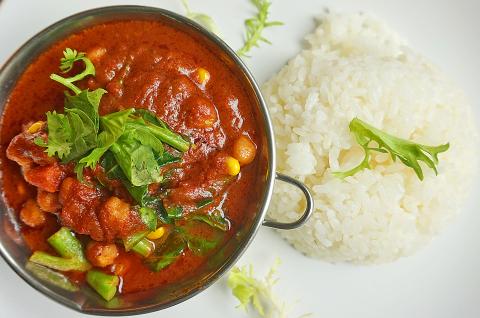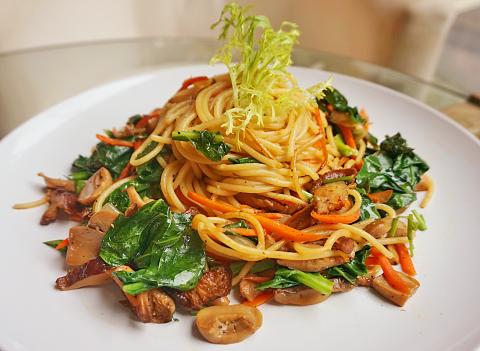“If you can’t tell the difference between a vegan chocolate cake and a normal chocolate cake, just eat vegan ones in the future — they’re supposed to be healthier.” Words of wisdom from my mother.
A few hours earlier, my friend and I had planned to stuff our faces with juicy hamburgers after dining at Mianto (米愛多), a vegan restaurant on Xinsheng South Road (新生南路). I’ve had my share of vegan meals — all for the sake of food writing. But for someone raised on a steady diet of skewered pork and chicken curries, it was all bland and forgettable. Not to mention the pint-sized portions — hence the need for post-meal burger binges. The fact that Mianto was one of the two restaurants in Asia to make it on this year’s Vegans Are Cool outstanding restaurants list did make it more appealing. But the mere mention of chocolate cake made me concede.
Opened by South African expat Michel Cason and interior designer Antonio Chen (陳豐秀) over a year ago, the restaurant is a compact space with floor-to-ceiling glass windows looking out onto Lianyun Park (連雲公園). A bakery area occupies the entrance, where dark wood-paneled walls are covered with black-and-white portraits, evoking the vibe of a lower Manhattan cupcake joint. A raised platform where patrons must take off their shoes leads to the main dining area, which consists of communal tables, and a smaller seating area by the window for parties of two.

Photo: Dana Ter, Taipei Times
With burgers still on our minds, we place our orders — the highly recommended spaghetti al funghi (NT$250), chana ma soul la or chickpea curry (NT$250), a ciabatta plate (NT$150) and, of course, the vegan chocolate cake (NT$65).
I was pleasantly surprised to find that it wasn’t only the desserts that were delectable. The crunchy mix of shiitake mushrooms, spinach and shredded carrots in the spaghetti al funghi, pan-fried with onions, garlic and black pepper, was enough to convince me that it was possible for vegan food to be not just edible, but palatable as well. Smoky and slightly charred on the edges, the shiitake mushrooms — which are sourced from the misty mountains of Fuhsing District (復興) in Taoyuan — are the best component. I was grateful for the peppery kick combined with the natural sweetness of the carrots, both of which provided much flavor and texture to the spaghetti.
The chana ma soul la is a good choice for those who fear eating salads when dining with vegan friends. There’s not too much of a heavy curry taste in the dish. Rather, the assortment of Indian herbs soaked in a mildly spicy tomato-based curry tastes more like a sauce. The chickpeas — probably one of the blandest legumes imaginable — are enlivened by the minty, aromatic curry. Like the spaghetti al funghi, the ingredients in the chana ma soul la are crunchy and fragrant, but not overwhelmingly so. Though the dish is served with a scoop of white rice, I found myself scooping every last drop of the curry as if it were a bowl of rich, creamy soup.

Photo: Dana Ter, Taipei Times
While technically an appetizer, we treated the ciabatta plate as a side dish to nibble on in between main courses. It pairs well with the olive oil, balsamic vinegar and olives, although I preferred to use it to mop up the last drops of curry. The homemade bread is served fresh from the oven with no added sugar or preservatives. The bread is soft and fluffy on the inside with a crust that crumbled delicately.
Finally, the vegan chocolate cake lived up to my expectations — for the most part. While the sponge layers were a little dry, the runny top layer of melted chocolate more than made up for it. There was only a sliver of cream, which I appreciated as I’m not a big fan of over-the-top indulgence.
Chocolate cake aside, it will still take a lot of convincing to convert me to veganism, but Mianto manages to make vegan dining enjoyable and tasty with subtle but memorable flavors.
After we combed up the last crumb, my friend looked up from his empty plate and asked, “Burgers?”
There was no need. We walked away with full, satisfied stomachs.

Exceptions to the rule are sometimes revealing. For a brief few years, there was an emerging ideological split between the Democratic Progressive Party (DPP) and Chinese Nationalist Party (KMT) that appeared to be pushing the DPP in a direction that would be considered more liberal, and the KMT more conservative. In the previous column, “The KMT-DPP’s bureaucrat-led developmental state” (Dec. 11, page 12), we examined how Taiwan’s democratic system developed, and how both the two main parties largely accepted a similar consensus on how Taiwan should be run domestically and did not split along the left-right lines more familiar in

As I finally slid into the warm embrace of the hot, clifftop pool, it was a serene moment of reflection. The sound of the river reflected off the cave walls, the white of our camping lights reflected off the dark, shimmering surface of the water, and I reflected on how fortunate I was to be here. After all, the beautiful walk through narrow canyons that had brought us here had been inaccessible for five years — and will be again soon. The day had started at the Huisun Forest Area (惠蓀林場), at the end of Nantou County Route 80, north and east

Specialty sandwiches loaded with the contents of an entire charcuterie board, overflowing with sauces, creams and all manner of creative add-ons, is perhaps one of the biggest global food trends of this year. From London to New York, lines form down the block for mortadella, burrata, pistachio and more stuffed between slices of fresh sourdough, rye or focaccia. To try the trend in Taipei, Munchies Mafia is for sure the spot — could this be the best sandwich in town? Carlos from Spain and Sergio from Mexico opened this spot just seven months ago. The two met working in the

This month the government ordered a one-year block of Xiaohongshu (小紅書) or Rednote, a Chinese social media platform with more than 3 million users in Taiwan. The government pointed to widespread fraud activity on the platform, along with cybersecurity failures. Officials said that they had reached out to the company and asked it to change. However, they received no response. The pro-China parties, the Chinese Nationalist Party (KMT) and Taiwan People’s Party (TPP), immediately swung into action, denouncing the ban as an attack on free speech. This “free speech” claim was then echoed by the People’s Republic of China (PRC),